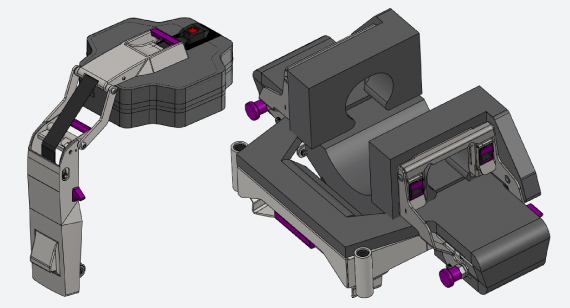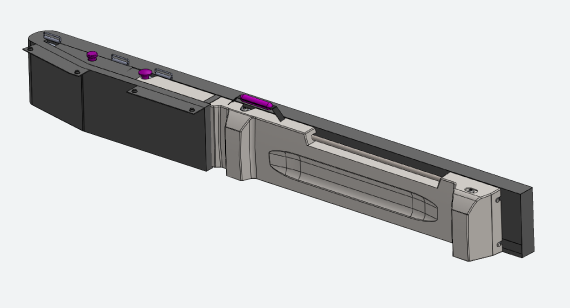
Revolutionizing Patient Care Through Automation
Turn Medical’s Pronova-O2 automated prone therapy system is causing a positive ripple effect on patient care, health care team safety and support, and improved efficiency for hospitals and care facilities. As part of its mission to bring game-changing products to market, the Protolabs Cool Idea Award grant funded prototyping and on-demand manufacturing of injection-molded plastic touch points used throughout the Pronova-O2 system. These purple touch points allow nurses and clinicians to safely place and adjust patients in much less time.

Supine Stress on the Body
For people hospitalized with certain lung and heart conditions, lying in a hospital bed on their backs (in a supine position) for days, sometimes weeks at a time can cause serious damage, especially if they’re also on a ventilator. According to Turn Medical CEO, Tara Psencik, the supine position causes the weight of the heart and abdomen to add additional pressure to already compromised fluid-filled lungs, making it even harder for the patient to breathe. As an alternative, a face down prone position has proven to improve the oxygenation process, allowing patients to breathe easier.
Manually maneuvering patients is tricky for everyone involved. It can take between six and eight caregivers to safely move a patient to the prone position. When done repeatedly, it can cause a lot of built up back and neck strain. For patients that are connected to IVs and intubation, it’s especially cumbersome to ensure everything remains intact during the transition. This labor-intensive process takes many hands, and with nursing shortages at an all-time high, it isn’t a sustainable solution.
Post-Pandemic Nursing Shortages
During the pandemic, stressful hours and resulting burnout caused nurses everywhere to leave the profession altogether to find a different career path. Per Psencik, about 25% of nurses are expected to leave the profession. “Over the next few years, this will leave an enormous gap at the bedside just to provide standard of care,” she said.
The Pronova-O2 is already helping relieve some of that stress for nurses. Psencik described a recent impactful visit at a hospital while Turn Medical staff were giving a demonstration of the system. “The nurses, physicians, and respiratory therapists in that facility were clapping and gave the team a standing ovation, many of them with tears in their eyes because they were exhausted from almost a year and a half of manually turning 16 to 20 patients a day. Turn Medical had provided them a solution.”
Adding Automation to Prone Positioning
The Pronova-O2 automates that process, allowing just one or two caregivers to place and secure the patient and program the computer system to move the patient to the desired position. Additionally, the system can accommodate patients up to 400 lbs. Once in the prone position, patients are not out of the woods.
According to Psencik, 76% of pressure injuries for patients that are in the prone position occur either on the face or the chest. To help mitigate that risk, Turn Medical created the disposable Intelliderm- powered skin protection system, which covers the face and chest. “The Intelliderm system reduces heat and moisture to help mitigate pressure injury risk in those high-risk areas,” said Psencik.
In health care, timing is critical. If a cardiac event occurs and providers need to perform CPR on a patient, the Pronova-O2 can transition from the prone to supine position in about 30 seconds, versus needing to gather multiple staff members to move the patient manually.


Purple Power: Pronova-O2 Touch Points
When brainstorming design components for the Pronova-O2 , the Turn Medical team decided that having a color-coded system would provide an intuitive design. The purple touch points are incorporated throughout the system with buttons and levers, as well as in the touch screen interface.
For Psencik, the plastic ABS material in the stock purple color that Protolabs offers (that also fits Turn Medical’s company color palette) was an obvious fit. The material is flame retardant, RoHS compliant, and high flow. “The color purple represents a lot of things. Strength, transformation, and wisdom. From an education perspective, having these purple touch points throughout creates a seamless way to implement the system,” she said.
Wilson explained that the injection molding service from Protolabs was much more cost-effective compared to other alternatives. “Protolabs offers us a huge benefit. To be able to get an injection-molded part quickly that’s relatively inexpensive, is huge from a from a cost and a development time standpoint,” said Turn Medical’s lead engineer, Kevin Wilson.
So far, the Pronova-O2’s purple touch points have received glowing reviews from nurses and physicians. “Lots of clinicians will have an easier pathway to implementation just by using the Pronova with the touch points and the user interface,” explained Wilson. It’s been a big contribution from Protolabs, so we appreciate the partnership.”





